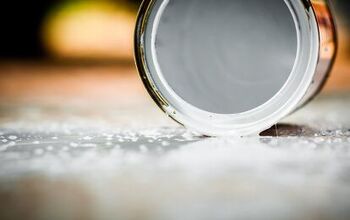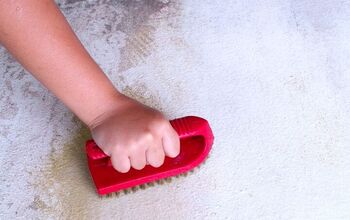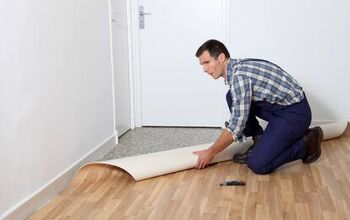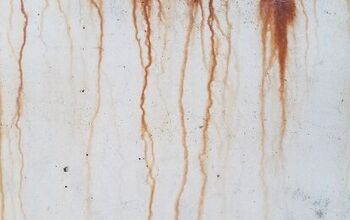How To Remove Paint From Concrete (4 Ways To Do It)

Concrete is considered to be one of the most affordable flooring options, also requiring very little maintenance. If you ever accidentally drip paint onto your concrete floor, it can be a time-consuming endeavor to remove. However, with the proper tools, knowledge, and patience, you’ll have that undesirable paint spill cleaned up in no time.
Drag a paint scraper across the paint stain to remove the top layer, then apply a paint stripper chemical. Soak the paint stains with your paint stripper and apply them several times over 20-40 minutes. Allow the paint stripper to soak and dry, then scrape the area again to remove the paint.
While it can be a challenging process to remove paint from concrete, it is not impossible. How long it takes to fully remove the paint will depend on the size of the area that you are addressing. Overall, you can expect it to be a somewhat time-consuming process, and one that likely won’t be completed over a weekend.
Regardless, we’ve put together an essential guide for removing even the most stubborn paint from your concrete flooring. Whether the paint was accidentally dripped or intentionally applied to the concrete surface, read on to learn how to tackle everything from large paint removals to small spills.
Do You Need Exterior Home Paint or Stain Services?
Get free, zero-commitment quotes from pro contractors near you.

Before You Start
When accidental paint splatters occur on sealed or untreated concrete flooring, removal is essential to maintaining a clean appearance. However, when it comes to concrete that has been painted intentionally, if you want to repaint it you need to make the decision as to whether or not the existing paint should be stripped away completely.
If you use the same type of paint (oil- or water-based) or primer, you won’t have to strip away the existing paint and can very easily paint right over it. If you want to repaint, start scraping off any flaking or peeling paint, sand, vacuum up the debris, and then you will be ready to paint over the concrete surface.
Quick Tip: Before you begin tackling the paint on your concrete, always take the necessary safety precautions. Make sure that you suit up with the appropriate protective clothing, including goggles and a respirator. The respirator will help protect you from the paint fumes and the possible existence of lead.
Cleaning the Concrete Surface
The first step in removing paint from your concrete is to clear the area of any debris or dirt. Use a broom and/or a vacuum cleaner to make this process easier. After you’ve swept away the surface grime, you’ll want to prepare a solution of either warm water and mild soap, or warm water with a trisodium phosphate alternative (TSP).
With one of these two solutions, use a wide wire brush to scrub away any stuck-on dirt. Use special care when handling TSP, as it is a toxic substance. Wear gloves, goggles, and a long sleeve shirt to protect yourself. Allow between two and three hours for the solution to dry once you’re done scrubbing.
Trisodium phosphate is banned in some states because these detergents can be harmful to the environment. If you’re concerned about safety, you can choose to use TSP substitute for this step instead.
Method #1: Removing Small Wet Paint Spills
For small paint spills on concrete, you’ll want to act quickly to remove it. Using an old cloth, start at the edges to wipe up the paint. Wipe from the ends towards the center to avoid spreading or smearing the wet paint.
After you’ve wiped up the physical paint splatters, prepare a solution of one-half gallon of warm water to one tablespoon mild dishwashing liquid in a bucket. With either a heavy-duty or wire scrub brush, saturate the brush in the solution and use it to scrub away any remaining evidence of the paint.
If this does not remove all of the paint, or it has dried slightly, you can try applying a paint thinner to the surface. Place the paint thinner on the affected area of concrete and allow it to settle for up to thirty minutes. Once the time is up, use a wire brush or paint scraper to detach the paint from the surface. Then, finish up by rinsing the area clean with water.
Quick Tip: Paint thinners generally only work for removing paint that is still wet. For paint that has dried, acetone tends to be the only solvent that is strong enough to remove it. You should avoid using paint thinners with latex paints.
Method #2: Remove Tough or Dry Paint Spills
For older, tougher, or dried paint spills, you still want to begin by cleaning the surface. Sweep up the dust or debris or use a shop vacuum for best results. Then, follow up with a metal paint scraper for flaking or peeling areas and sweep up any debris afterward.
You’ll then want to assemble the materials for making an absorbent paint stripper. For this, you’ll need a paint stripper, an absorbent material such as finely ground clay or cat litter crushed into a power, a stiff brush, and scouring powder. If you are working in a well-ventilated space such as outdoors or anywhere with proper ventilation, you can use a stripper with methylene chloride. After you’ve gathered your materials, follow these steps to effectively remove the paint:
- Mix the paint stripper with your absorbent material. Make a paste-like material using your cat litter or clay and the paint stripper. The amount of stripper you need to add to the mixture will depend on its thickness.
- Apply the mixture to the affected area. Once you’ve achieved a paste-like consistency, apply a layer to the painted area on the concrete. Allow ample time for the stripper to do its work, this process could take anywhere from twenty minutes to several hours.
- Scrape the mixture off. After you’ve allowed the appropriate amount of time for the stripper to work, it should be very easy to remove the paint by simply scraping the mixture away with a plastic scraping device. Apply a second layer and repeat the process as needed.
- Scrub the concrete. To remove any excess paint particles, use water, scouring powder, and a coarse wire brush. Finish off by rinsing the scouring mixture and scrubbing the area clean with the brush.
- Use a power washer. When you’ve finished scrubbing, you have the option of following up with a power washer or high-powdered garden hose. The high-water pressure will help to get rid of any stubborn paint residue. Power washers work especially well on outdoor surfaces such as driveways, walkways, and concrete walls.
Once you’ve completed all of the above steps, examine the area and repeat if necessary.
Method #3: Removing Large Areas of Paint From Concrete
If you have exceptionally large spills or decide that you want to remove pre-existing paint from your concrete before repainting, you have several steps to follow. You’ll first want to start by removing any items from the concrete area and follow up with using a wire brush or metal paint scraper to pry away loose, chipped, or peeling paint.
Then, eradicate any dust or debris with a vacuum or broom and dustpan. If you have an exceptionally dirty concrete surface, you can use a hose or power washer to clean it. However, make sure that you wait until the concrete has dried completely before proceeding. Once the area has had several hours to dry, follow these steps:
- Purchase a paint stripper. The type of paint stripper you choose will depend on the type of paint on the concrete. For oil-based paints, select an oil-based stripper. For latex acrylic paints, use either a plant-based stripper or water-based version. If you’re unsure of the type of paint on your concrete, go with an oil-based stripper.
- Apply the paint stripper to the concrete. Follow the manufacturer’s instructions, applying a thick coat of stripper to the concrete with an old paintbrush. Let it sit for the suggested amount of time, typically several hours. When the paint starts to bubble away from the surface, this indicates that the stripper is working.
- Scrape away the paint. Make sure that you are wearing the necessary protective gear before you begin this step. Then, use a wire brush and/or metal scraper to eliminate the paint and paint stripper from the surface. Have a bucket or tarp nearby to collect the soppy mess.
- Rinse the concrete surface. Once you’ve scraped away as much of paint and striper as you can, use a pressure washer or garden hose to rinse the area. Once the surface has dried you will be able to determine whether or not repeating the steps and adding a second coat of paint stripper is necessary.
Method #4: Removing Paint from Concrete Naturally
If you are apprehensive about using chemicals or just prefer to go the natural route, consider soda blasting for removing paint from concrete. In fact, soda blasting may be the best method for removing paint that covers a large area, even better than using a paint stripper.
Soda blasting involves using baking soda as a scouring agent for removing paint from the surface of your concrete. This method is very environmentally friendly and won’t cause any potential damage to the concrete underneath. It essentially works the same way as a paint stripper, but is less abrasive on the surface.
- Gather your materials. Before you begin the process of soda blasting, you need to obtain a blasting unit and a special sodium bicarbonate. For soda blasting, you specifically need a pot blaster. You can purchase one or rent one from a local hardware store. When it comes to sodium bicarbonate, household baking soda is too fine for this method. Instead, the proper form can be found either online or where you obtained your specialized soda blaster.
- Blast the painted concrete area. Make sure that you wear a respirator before you begin this step to avoid inhaling any flying particles. Moving slowly, hold the nozzle of the blaster a safe distance away, or about a foot and a half from the concrete surface.
- Use special care around vegetation. If you are soda blasting near vegetation, make sure to avoid getting any particles on the plants. The high pH levels of the sodium bicarbonate can result in browning or death in both bushes and flowers. Remove or cover any plants that could be affected by the blaster.
- Consider hiring a professional. If you’re unsure about your ability to operate a soda blaster, consider enlisting the help of a professional. The size of the blasting unit and the amount of material needed alone may be too much for you to manage on your own.
Do You Need Exterior Home Paint or Stain Services?
Get free, zero-commitment quotes from pro contractors near you.

Related Questions
Does vinegar remove paint from concrete?
In addition to soda blasting, vinegar can be another natural way for removing paint from concrete. Vinegar is inexpensive, simple, and effective at removing stuck-on paint from various hard surfaces. You’ll first want to heat up the vinegar on the stove or in a microwave. Then, use a sponge or paintbrush to apply the hot vinegar to the paint.Allow between ten and fifteen minutes for the vinegar to soak in and soften up the paint. To remove the softened paint, use a paint scraper. Apply more hot vinegar and repeat these steps as needed.
Can a pressure washer remove paint from concrete?
A pressure washer can be a useful tool for getting paint off of concrete. However, poured concrete is much better at handling high-pressure cleaning than covered concrete. You should use pressure washing as one of the last steps to cleaning paint off concrete, after you’ve already scrubbed or scraped the paint away.
Does all of the paint need to be removed from the concrete before repainting?
No, you do not have to completely remove pre-existing paint prior to repainting. However, if you are unsure if the paint will cover, you should do a light sanding and then apply a sealer or primer. As long as the existing paint is holding up well, you can apply a fresh coat of paint right over it.

Jessica considers herself a home improvement and design enthusiast. She grew up surrounded by constant home improvement projects and owes most of what she knows to helping her dad renovate her childhood home. Being a Los Angeles resident, Jessica spends a lot of her time looking for her next DIY project and sharing her love for home design.
More by Jessica Stone



























